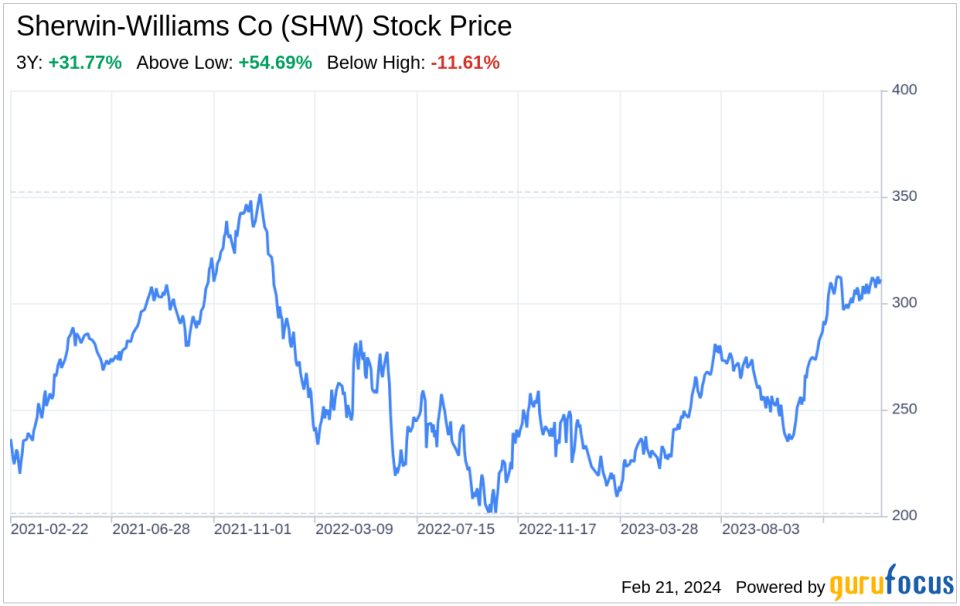Decoding Sherwin-Williams Co (SHW): A Strategic SWOT Insight
Strengths: Dominant market presence and comprehensive product portfolio.
Weaknesses: Dependence on raw material availability and potential supply chain disruptions.
Opportunities: Expansion into emerging markets and potential for digital transformation.
Threats: Intense competition and vulnerability to economic fluctuations.
On February 20, 2024, Sherwin-Williams Co (NYSE:SHW), a leader in the architectural paint industry in the United States, filed its 10-K report, revealing the financial performance and strategic positioning of the company. With a network of over 5,000 stores, Sherwin-Williams not only sells premium paints but also offers a wide array of paint-related products and coatings for original equipment manufacturers. The company's financial tables from the filing highlight a robust financial position, with a market capitalization of $68,095 million as of June 30, 2023. The company's strategic initiatives, including the divestiture of non-core businesses and the acquisition of SIC Holding GmbH, reflect a focused approach to optimizing its product portfolio and expanding its global footprint.

Strengths
Market Dominance and Brand Equity: Sherwin-Williams Co (NYSE:SHW) stands as a titan in the architectural paint sector, with a commanding presence in the United States and a growing international footprint. The company's brand equity is built on a foundation of quality, innovation, and customer loyalty, which has been nurtured over its extensive history. The strength of its brand is evident in its expansive network of company-operated specialty paint stores, which serve as a direct channel to consumers and professional contractors. This direct-to-consumer model not only ensures control over the brand experience but also provides valuable insights into customer preferences and market trends.
Financial Resilience: The financial health of Sherwin-Williams is a testament to its operational efficiency and strategic management. With a solid balance sheet and consistent revenue streams, the company has demonstrated its ability to weather economic cycles and invest in growth opportunities. The financial tables from the 10-K filing underscore the company's strong cash flow generation and profitability, which are critical in funding research and development, store expansions, and technological advancements. This financial resilience positions Sherwin-Williams to capitalize on market opportunities and maintain its competitive edge.
Weaknesses
Raw Material Sourcing and Cost Volatility: A significant challenge for Sherwin-Williams Co (NYSE:SHW) is the reliance on raw materials that are subject to price fluctuations and availability constraints. The company's cost of goods sold is heavily influenced by the cost of resins, pigments, solvents, and containers, many of which are derived from petrochemical feedstocks. Volatility in these input costs can impact margins and necessitate price adjustments, which may not always be feasible in a competitive market. Additionally, supply chain disruptions, whether due to geopolitical events, natural disasters, or industry capacity constraints, can pose risks to production continuity and customer fulfillment.
Environmental Compliance and Sustainability Pressures: As a manufacturer of chemical-based products, Sherwin-Williams faces ongoing challenges related to environmental compliance and sustainability. The company incurs significant capital expenditures to meet regulatory requirements and invest in eco-friendly product development. While these investments are necessary for long-term viability, they can strain short-term financial performance and require careful balancing of environmental responsibilities with shareholder expectations.
Opportunities
Global Expansion and Market Penetration: Sherwin-Williams Co (NYSE:SHW) has significant opportunities to expand its global reach, particularly in emerging markets where demand for architectural paints and coatings is on the rise. The acquisition of SIC Holding GmbH is a strategic move that enhances the company's presence in Europe and provides a platform for further international growth. By leveraging its strong brand and adapting products to local tastes and regulations, Sherwin-Williams can tap into new customer segments and diversify its revenue base.
Technological Innovation and Digital Engagement: The paint industry is ripe for digital transformation, and Sherwin-Williams is well-positioned to lead this charge. Investing in digital tools and platforms can enhance customer engagement, streamline operations, and unlock new revenue streams. For instance, augmented reality applications for color selection, online sales channels, and data analytics can improve the customer experience and operational efficiency. Embracing digital innovation can also attract a younger demographic and reinforce the company's reputation as a forward-thinking market leader.
Threats
Competitive Landscape and Price Sensitivity: Sherwin-Williams Co (NYSE:SHW) operates in a highly competitive industry, with numerous local, regional, and international players vying for market share. The company must continuously innovate and deliver value to maintain its leadership position. Price sensitivity among consumers and contractors can lead to a reliance on promotional activities and discounts, which can erode profitability. Moreover, the emergence of new competitors, particularly those with disruptive business models or lower cost structures, can challenge Sherwin-Williams' market dominance.
Economic Cycles and Consumer Confidence: The demand for Sherwin-Williams' products is closely tied to the health of the retail and manufacturing economies. Economic downturns, rising interest rates, and shifts in consumer confidence can lead to reduced spending on home improvement and construction projects, directly impacting paint sales. The company must navigate these macroeconomic headwinds and adapt its strategies to sustain growth during periods of economic uncertainty.
In conclusion, Sherwin-Williams Co (NYSE:SHW) exhibits a robust strategic and financial framework, characterized by a strong market presence, a comprehensive product portfolio, and a solid balance sheet. However, the company must address challenges related to raw material sourcing, environmental compliance, and intense competition. By capitalizing on opportunities for global expansion and technological innovation, Sherwin-Williams can fortify its position and drive long-term growth, despite the ever-present threats posed by economic fluctuations and competitive pressures.
This article, generated by GuruFocus, is designed to provide general insights and is not tailored financial advice. Our commentary is rooted in historical data and analyst projections, utilizing an impartial methodology, and is not intended to serve as specific investment guidance. It does not formulate a recommendation to purchase or divest any stock and does not consider individual investment objectives or financial circumstances. Our objective is to deliver long-term, fundamental data-driven analysis. Be aware that our analysis might not incorporate the most recent, price-sensitive company announcements or qualitative information. GuruFocus holds no position in the stocks mentioned herein.
This article first appeared on GuruFocus.
